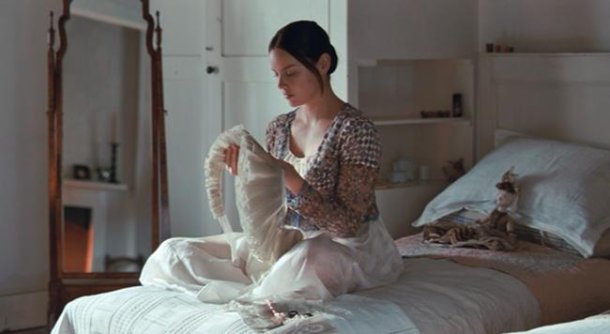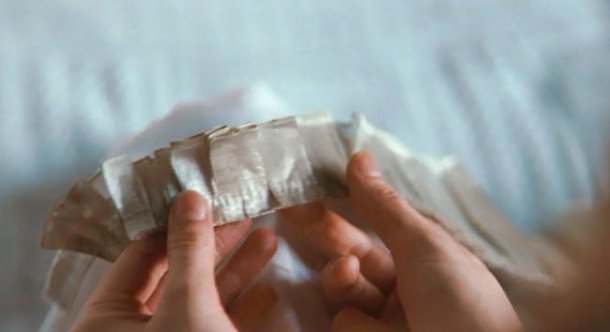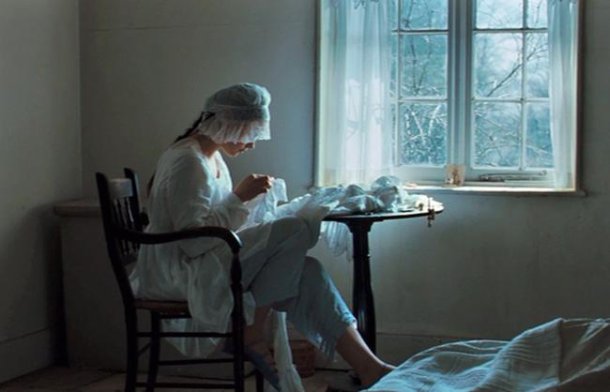
A common strategy used by many critics of contemporary historical films and costume dramas is to locate such films within the critical mode of a postmodern nostalgia. Such a postmodern nostalgia is defined by what Cora Kaplan calls the “much debated view that the passage from modernity to postmodernity has been marked by the profound loss of a sense of history.”[1] Fredric Jameson’s now famous indictment of postmodernism is often used to illustrate this “profound loss”. Jameson’s Postmodernism, or, the Cultural Logic of Late Capitalism, begins with the declaration that “it is safest to grasp the concept of the postmodern as an attempt to think the present historically in an age that has forgotten how to think historically in the first place.”[2] Instead, Jameson argues that postmodernism functions through “the random cannibalization of all the styles of the past”, creating a “loss of historicity”.[3]
This is not a new argument by now. From Jameson’s critique of postmodernism, we have fashioned a mode of postmodern nostalgia defined by the commodification, aestheticisation and deconstruction of the past in the present. The idea that our modern culture functions via the flattening out of history as a marketable “image” or a commodified “style” is assumed as fact. And it is a fact that is applied to a whole host of contemporary historical and period films that utilise the appeal of the past through a type of museum aesthetic, where the cultural legacy of the past is displayed as a pleasing aesthetic, and nothing more. I don’t deny the logic of such an argument, but I also believe there is a considerable search for substance that goes hand-in-hand with our rampant consumption of style and image, which moves us beyond postmodernism. It is a search for substance that begins with the very meaning of the word “nostalgia”.

The original meaning of “nostalgia” stems from two Greek words: nostos, meaning to return home, and algia, meaning pain or longing.[4] Perhaps we are too stuck in the “pain”, in the algia, in our approach to the kind of cultural work contemporary historical films perform. We are languishing in apathy toward such films, and an assumption that, at best, what they offer us in critical terms is a reflection of the superficial wallowing in aestheticised consumption that defines modern culture. In other words, we are stuck in Jameson’s postmodernist pain. But maybe it is time to move away from the pain, to confront our loss of innocent engagement with the idea of history by shifting the focus to the other side of nostalgia: home.
What does returning home even mean? “Home” has many connotations: it implies a comforting domestic space, a sense of belonging, a site of cultural familiarity and the enclosure of fondly remembered boundaries. It also has political and national implications: “home” is the nation, the country, the land. Such boundaries and spaces are antithetical to postmodernist deconstruction, which is inherently suspicious of ties that bind and the search for identity and belonging. And yet, this is precisely what many historical films explore. Popular costume dramas set in the past and historical period films often take us into private domestic spaces and houses, enacting narratives of belonging and identity in the present through a re-imagined history. One of the most interesting examples of this is Jane Campion’s recent film, Bright Star (2009).
Bright Star is predicated on a consciously invented history. In many ways, the film is a primary example of postmodernist critical techniques at work, as it is essentially a revisionist history. Based on the biography of the Romantic poet, John Keats, Bright Star cleverly rewrites the real history of the poet by shifting the focus from him onto the object of his affection: Fanny Brawne. Campion is not concerned with whether her approach to his biography and his historical context is accurate. While loosely based on facts, Bright Star is more concerned with perspective: who is the focus of historical memory, who gets to tell the story and why.
By shifting the focus onto Fanny, Campion compels her audience to consider who is typically left out of official historical accounts: women, marginalised groups, those who have historically lacked power to voice their narratives. This is a familiar postmodernist technique. Deeply suspicious of “official” history and “facts”, postmodernism tends to approach history via a deconstructive methodology of stripping back the layers and revealing that everything is based on representation and power. And yet, after the layers have been stripped, postmodernism is content to leave us bare. Campion, on the other hand, is not.
Through Fanny, Campion fashions a re-enlivened Romanticism, a search for substance behind the style, that can ironically be found via the layers of her costumes. The very first image of the film is an extreme close-up of Fanny’s needle weaving in and out of fabric. As the camera moves out, it reveals the figure of Fanny, silently sewing within the cocooned space of her bedroom. Fanny’s contemplative sewing is afforded a unique significance as a form of artistic expression. Throughout the film, Campion calls upon her sewing as a metaphor for an interior subjectivity that perhaps most truly represents the Romantic identity of the film, rivalling Keats’s poetry. It is, in a sense, a form of forgotten feminine art and history.



In the same moment in which she utilises the postmodernist strategy of highlighting a marginalised history, Campion moves beyond postmodernism by stepping over the threshold between deconstruction and creation. Bright Star shows us that behind a deconstructed history lies art, creation, identity, interiority and substance. That is, Campion moves beyond the postmodernist claim that behind representation lies more empty representation. Fanny embodies the very idea of individual identity which remains a problematic concept for postmodernism, and which is perhaps best encapsulated via Romanticism.
I view Campion’s Bright Star as a metaphor for how to approach many other costume and period films. Looking at them purely as a form of aestheticised postmodern superficiality ignores their varied searches for something behind the beautiful veneer of representation, style and image. We may be deeply enamoured with the styles of the past, with representation over “fact”, and we may still be lingering in the pain of a loss of historicity. But we are no longer content to remain in nowhere land, without a home. Campion’s Bright Star reminds me that if, on the one hand, we continue to accumulate aestheticised imagery in place of substantial history and can no longer approach history with a credulous innocence, we are still, nevertheless, digging beneath this imagery with eyes wide open, searching for clues into who we are, where we belong, and how we choose to re-imagine that which has been lost.
Fanny’s sewing is ultimately a form of connection; as it binds fabric together, it also binds her character and her history with a contemporary audience. Empathising with her private interiority means investing in the idea that we are, after all, wholly substantial, not empty holograms of representation. To me, this is a movement beyond postmodernism into metamodernism. It is a desire to locate ourselves within both creation and deconstruction, both then and now. A fitting testimony to the complexity of our times.
All images are screengrabs from Jane Campion’s Bright Star (2009).
Notes
[1] Kaplan, Cora (2007): Victoriana: Histories, Fictions, Criticism, Edinburgh: Edinburgh University Press, p. 3.
[2] Jameson, Fredric (1991): Postmodernism, or, the Cultural Logic of Late Capitalism, Durham, N.C.: Duke University Press, p. ix.
[3] Jameson, Fredric (1991): Postmodernism, or, the Cultural Logic of Late Capitalism, Durham, N.C.: Duke University Press, pp. x-ix.
[4] Powrie, Phil (1997): French Cinema in the 1980s: Nostalgia and the Crisis of Masculinity, Oxford: Clarendon Press, p. 16.

This article comes at a good time for me. I am referring to contemporary cinema (mainly by Jane Campion) when I discuss the visual style of my work and the aesthetic choices I have made throughout the project. The style of all the artists, directors, writers etc that I enjoy and refer to often are dismissed as superficial or stylistic indulgence. But while I always knew there was so much more to it than that I never spent long enough thinking about to put my finger on it, I think you have put it better than I could have. While reading this I kept thinking of Fanny’s love of beautiful dresses and her pride in them despite the male characters teasing her for it. Interesting article.
Yes, I totally agree Sundari. I think a lot of these films, and the stylistic choices on which they are based (which extends to photographic modes too), are often casually dismissed. I personally think there is a deeper reason for why we’re drawn to them. And I can’t help feeling like there’s also a latent sexism involved in their dismissal – i.e. they’re often considered “chick flicks” or “women’s films”. I love how Campion turns Fanny into an artist. Everyone around her dismisses her artistry as fluffy women’s work, but she resists such a dismissal throughout the film. I approach her persona as a desire to escape the narrow boundaries of criticism surrounding such films.
Thank you very much for writing this article. It was very surprising to read these lines because they have very close resemblance to my unfinished master´s thesis on very different topic though. It seems we have been looking the same films with the same mindset.
I always suspected we had much in common. I’d love to hear more about your master’s thesis.
I had never heard of this film. I find it interesting that Fanny is and her sewing is placed in her room, whereas any indication of womanly accomplishments is normally placed in a less private place. More importantly, confined to a specific place (parlour, drawing room?). A room where women went to do what they ought to be doing.
Depicting sewing as an art, a task chosen when in private, as a personal reward, gives the art and the woman enormous substance.
Many period films show the women looking bored getting on with their tasks. And the concept of substance seems to be shown in having them choose specific alternatives – reading or horse-riding. Traditionally masculine pastimes.
Excellent discussion but a 3yr-old beckons…
It’s a complex subject because on the one hand, women have traditionally been associated with domestic and private realms. But on the other hand, they are rarely afforded an interior subjectivity with the same depth as masculine representations of identity. So I suppose Fanny’s characterisation could have gone either way, but I think Campion imbues her with depth, rather than trying to locate her within stereotypical ideas of femininity. I hope that makes sense!